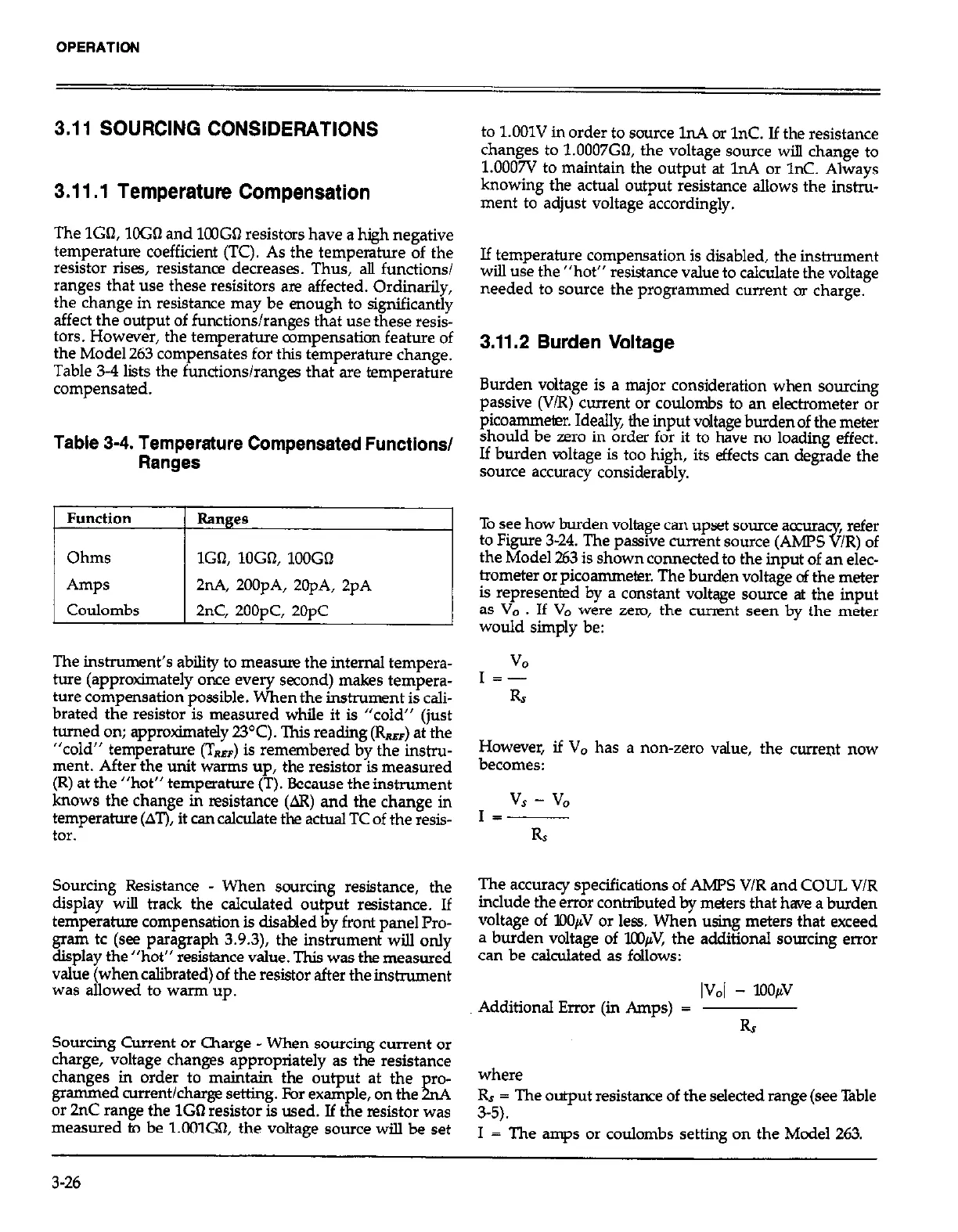OPERATION
3.11 SOURCING CONSIDERATIONS
3.11 .l Temperature Compensation
The lG62, lOGIl and lOOGO resistors have a high negative
temperature coefficient (TC). As the temperature of the
resistor rises, resistance decreases. Thus, all functions/
ranges that use these resisitors are affected. Ordinarily,
the change in resistance may be enough to significantly
affect the output of functions/ranges that use these resis-
tors. However, the temperature compensation feature of
the Model 263 compensates for this temperature change.
Table 3-4 lists the functions/ranges that are temperature
compensated.
Table 3-4. Temperature Compensated Functions/
Ranges
Function
Ranges
Ohms
lG0, lOGi?, lOOGO
Amps
ZnA, ZOOpA, ZOpA, 2pA
Coulombs
2nC, 2oopc, 2Opc
The instrument’s ability to measure the internal tempera-
ture (approximately once every second) makes tempera-
ture compensation possible. When the instrument is cali-
brated the resistor is measured while it is “cold” (just
turned on; approximately 2PC). ‘lhis reading (Rx& at the
“cold” temperature (TaEF) is remembered by the instru-
ment. After the unit warms up, the resistor is measured
(R) at the “hot” temperature (T). Because the instrument
knows the change in resistance (AR) and the change in
temperature (AT), it can calculate the actual TC of the resis-
tor.
Sourcing Resistance - When sourcing resistance, the
display will track the calculated output resistance. If
temperature compensation is disabled by front panel Pro-
gram tc (see paragraph 3.9.3), the instrument will only
display the “hot” resistance value. This was the measured
value (when calibrated) of the resistor after the instrument
was allowed to warm up.
Sourcing Current or Charge - When sourcing current or
charge, voltage changes appropriately as the resistance
changes in order to maintain the output at the ro-
gr-ed current/charge setting. For example, on the
%A
or 2nC range the lGI7 resistor is used. If the resistor was
measured to be l.OOlGII, the voltage source will be set
to l.OOlV in order to source 1nA or 1nC. If the resistance
changes to 1.0007GQ the voltage source will change to
1.0007V to maintain the output at 1nA or Inc. Always
knowing the actual output resistance allows the instru-
ment to adjust voltage accordingly.
If temperature compensation is disabled, the instrument
will use the “hot” resistance value to calculate the voltage
needed to source the programmed current or charge.
3.11.2 Burden Voltage
Burden voltage is a major consideration when sourcing
passive (ViR) current or coulombs to an electrometer or
picoammeter. Ideally, the input voltage burdenof the meter
should be zero in order for it to have no loading effect,
If burden voltage is too high, its effects can degrade the
source accuracy considerably.
To see how burden voltage can upset source accura
to Figure 3-24. The passtve current source (AMPS
T
refer
/R) of
the Model 263 is shown connected to the input of an elec-
trometer or picoammeter. The burden voltage of the meter
is represented by a constant voltage source at the input
as V, If V0 were zero, the current seen by the meter
would simply be:
However, if V0 has a non-zero value, the current now
becomes:
vs - vo
I=
R
The accuracy specifications of AMPS V/R and COLIC V/R
include the error contributed by meters that have a burden
voltage of lOO$ or leas. When using meters that exceed
a burden voltage of ICI&V, the additional sourcing error
can be calculated as follows:
IV,/ - lav
Additional Error (in Amps) =
where
Fs; The output resistance of the selected range (see labable
I = The amps or coulombs setting on the Model 263.
3-26

